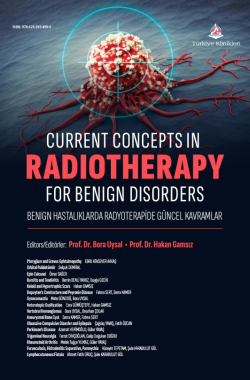Keloid and Hypertrophic Scars
Hakan GAMSIZa
aUniversity of Health Sciences Gülhane Faculty of Medicine, Department of Radiation Oncology, Ankara, Türkiye
Gamsız H. Keloid and hypertrophic scars. In: Uysal B, Gamsız H, eds. Current Concepts in Radiotherapy for Benign Disorders. 1st ed. Ankara: Türkiye Klinikleri; 2025. p.18-21.
ABSTRACT
Fibroproliferative benign diseases such as hypertrophic scars and keloids are caused by abnormal wound healing in susceptible individuals after burns, surgery, inflammation, or trauma. While the exact mechanism remains unclear, keloids exhibit distinct characteristics of fibroblasts compared to those in normal skin. Keloids can manifest months or years after skin damage and may continue to grow independently. They are more prevalent in individuals with a family history and are commonly observed in the 10-30 age group. Various treatment modalities are available, including intralesional steroid injections, surgical excision, cryotherapy, laser therapy, radiation therapy, and application of silicone gel sheets. Radiation therapy, particularly when combined with surgery within 24-48 hours, emerges as an effective and safe treatment approach. Electron therapy, superficial or orthovoltage X-rays, and brachytherapy represent viable RT options, each with distinct advantages and limitations. Using several fractions with higher doses per fraction is recommended in radiation therapy planning for optimal outcomes in keloid management.
Keywords: Keloid; cicatrix, hypertrophic; radiotherapy; brachytherapy
Kaynak Göster
Referanslar
- Eng TY, Abugideiri M, Chen TW, Madden N, Morgan T, Tanenbaum D, et al. Radiation Therapy for Benign Disease: Keloids, Macular Degeneration, Orbital Pseudotumor, Pterygium, Peyronie Disease, Trigeminal Neuralgia. Hematol Oncol Clin N Am. 2020;34:229-51. [Crossref] [PubMed]
- Ghazawi FM, Zargham R, Gilardino MS, Sasseville D, Jafarian F. Insights into the pathophysiology ofHypertrophic Scars and Keloids: How Do They Differ? Adv Skin Wound Care. 2018;31(1):582-95. [Crossref] [PubMed]
- Lee JW, Seol KH. Adjuvant Radiotherapy after Surgical Excision in Keloids. Medicina. 2021;57:730. [Crossref] [PubMed] [PMC]
- Luo L, li J, Liu H, Jian X, Zou Q, Zhao Q, et al. Adiponectin Is Involved in Connective Tissue Growth Factor-Induced Proliferation, Migration and Overproduction of the Extracellular Matrix in Keloid Fibroblasts. Int J Mol Sci. 2017;18(5):1044. [Crossref] [PubMed] [PMC]
- Davis SA, Feldman SR, McMichael AJ. Management of keloids in the United States, 1990-2009: an analysis of the National Ambulatory Medical Care Survey. Dermatol Surg. 2013;39(7):988-94. [Crossref] [PubMed]
- Arno AI, Gauglitz GG, Barret JP, Jeschke MG. Up-to-date approach to manage keloids and hypertrophic scars: auseful guide. Burns. 2014;40(7):1255-66. [Crossref] [PubMed] [PMC]
- Andrews JP, Marttala J, Macarak E, Rosenbloom J, Uitto J. Keloids: The paradigm of skin fibrosis-pathomechanisms and treatment. Matrix Biol. 2016;51:37-46. [Crossref] [PubMed] [PMC]
- Lumenta DB, Siepmann E, Kamolz LP. Internet-based survey on current practice for evaluation, prevention, andtreatment of scars, hypertrophic scars, and keloids. Wound Repair Regen. 2014;22(4):483-91. [Crossref] [PubMed]
- Ogawa R, Akita S, Akaishi S, Aramaki-Hattori N, Dohi T, Hayashi T, et al. Diagnosis and Treatment of Keloids and Hypertrophic Scars-Japan Scar Workshop Consensus Document 2018. Burns Trauma. 2019;7:39. [Crossref] [PubMed] [PMC]
- Leventhal D, Furr M, Reiter D. Treatment of keloids and hypertrophic scars: a meta-analysis and review of the literature. Arch Facial plast Surg. 2006;8:362-8. [Crossref] [PubMed]
- De Bearman R, Gourgerot H. Cheloides des Maqueuses. Ann Dermatol Syphilol. 1906;7:151.
- Mustoe TA, Cooter RD, Gold MH, Ziegler UE. International advisory panel on scar management: international clinical recommendations on scar management. Plast Reconstr Surg. 2002;110:560-71. [Crossref] [PubMed]
- Lee HJ, Jang YJ. Recent understandings of biology, prophylaxis and treatment strategies for hypertrophic scars and keloids. Int J Mol Sci. 2018;19(711):1-19. [Crossref] [PubMed] [PMC]
- Mankowski P, Kanevsky J, Tomlinson J, Dyachenko A, Luc M. Optimizing radiotherapy for keloids: a meta-analysis systematic review comparing recurrence rates between different radiation modalities. Ann Plast Surg. 2017;78:403-11. [Crossref] [PubMed]
- Jiang P, Geenen M, Siebert F, Druecke D. Efficacy and the toxicity of the interstitial high-dose-rate brachytherapy in the management of recurrent keloids: 5-year outcome. Brachytherapy. 2018;17:597-600. [Crossref] [PubMed]
- Ogawa R, Tosa M, Dohi T, Kuribayashi S. Surgical excision and postoperative radiotherapy for keloids. Scars Burn Heal. 2019;5:1-11. [Crossref] [PubMed] [PMC]
- Shen J, Lian X, Sun Y, Wang X, Hu K, Hou X, et al. Hypofractionated electron-beam radiation therapy for keloids: Retrospective study of 568 cases with 834 lesions. J Radiat Res. 2015;56:811-7. [Crossref] [PubMed] [PMC]
- Recalcati S, Caccialanza M, Piccinno R. Postoperative radiotherapy for auricular keloids: a 26-year experience. J Dermatol Treat. 2011;22:38-42. [Crossref] [PubMed]
- Van Leeuwen MCE, Stokmans SC, Bulstra AJ, Meijer OWM, van Leeuwen PAM, Niessen FB. High-dose-rate brachytherapy for the treatment of recalcitrant keloids: A unique, effective treatment protocol. Plast Reconstr Surg.2014;134:527-34. [Crossref] [PubMed]
- Hafkamp CJH, Lapid O, Dávila Fajardo R, van de Kar AL, Koedooder C, Stalpers LJ, et al. Postoperative single-dose interstitial high-dose-rate brachytherapy in therapy-resistant keloids. Brachytherapy. 2017;16:415-20. [Crossref] [PubMed]
- Vila Capel A, Vilar Palop J, Pedro Olive A, Fernandez A. Adjuvance in refractory keloids using electron beam with a spoiler: recent result. Rep Pract Oncol Radiother. 2013;20:43-9. [Crossref] [PubMed] [PMC]
- Zainib M, Amin NP. Radiation Therapy in the Treatment of Keloids. 2023 Jul 31. In: Statpearls [Internet]. Treasure Island (Fl): Statpearls Publishing; 2024 Jan-.
- Cheraghi N, Cognetta A, Goldberg D. RADIATION THERAPY for the Adjunctive Treatment of SurgicallyExcised Keloids: A Review. J Clin Aesthet Dermatol. 2017;10(8):12-5.

